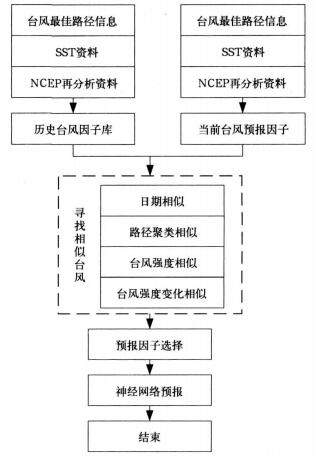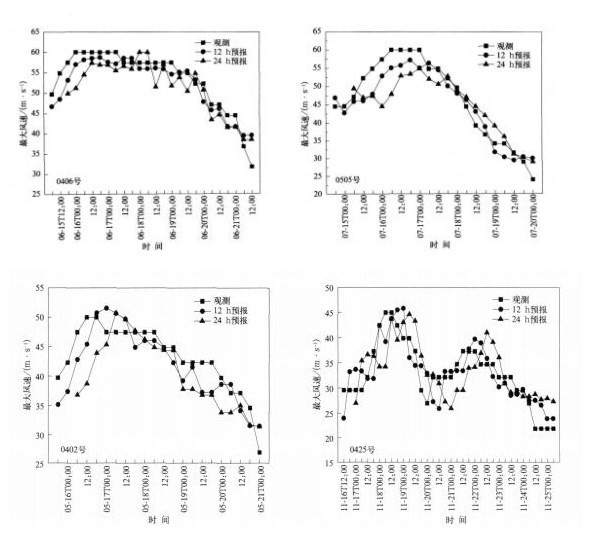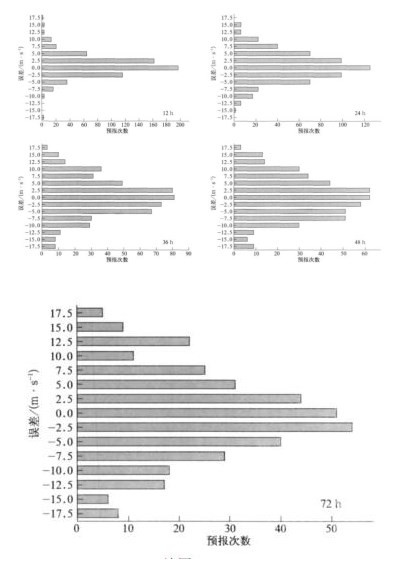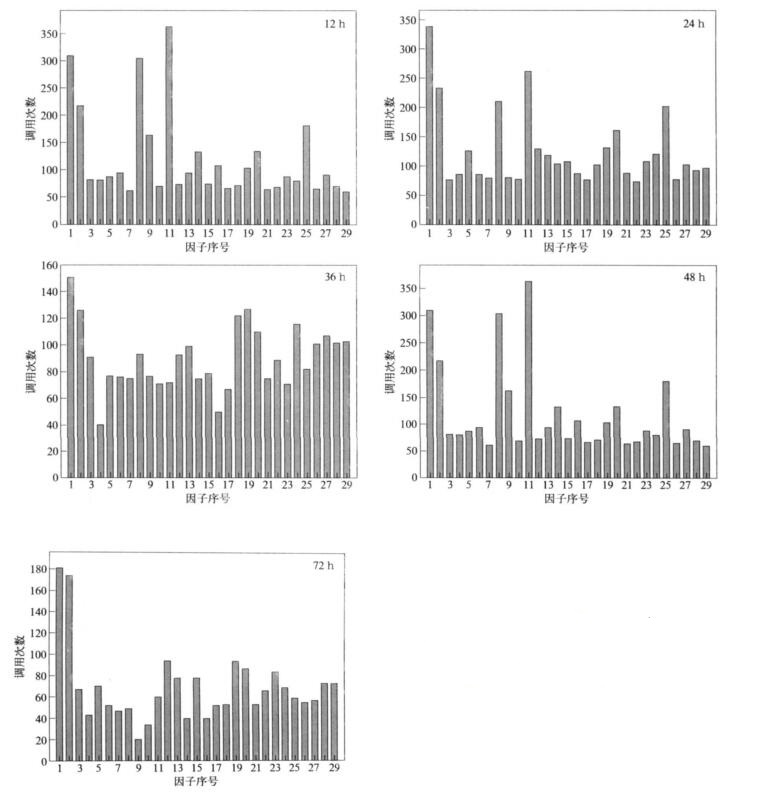利用神经网络方法建立热带气旋强度预报模型
A Neural Network Approach to Predict Tropical Cyclone Intensity
-
摘要: 以神经网络方法为基础,建立西北太平洋热带气旋强度预测模型,模型首先进行历史相似热带气旋选择。从选择的样本出发,计算得到一组气候持续因子、天气学经验因子和动力学因子, 对这些因子采用逐步回归方法进行筛选,将筛选得到的因子同对应时效的热带气旋强度输入神经网络训练模块,从而得到优化的预测模型。从2004-2005年西北太平洋26个热带气旋过程对12,24,36,48,72h等不同预报时效分别进行的634,582,530,478,426次预测试验结果的统计来看,相对于线性回归模型预测水平,该模型显著降低了各时段的预测误差。从几个热带气旋个例的预测结果来看, 该模型对超强台风, 以及具有强度迅速加强、再次加强等特征的热带气旋过程均有很好的描述能力。Abstract: An artificial neural network (ANN) technique is used to predict tropical cyclone intensity change in the Western North Pacific basin and the efficacy is examined. The intensity change forecasts produced by the ANN model are compared to the results of a model developed using linear regression by National Hurricane Center (NHC) at 12-hour,24-hour,36-hour, 48-hour, 72-hour forecast periods. The date, location, track, intensity and the intensity change similarities is used to identify a historical analog tropical cyclone to the current tropical cyclone.Once the analog tropical cyclone are identified, the climatology and persistence variables, such as the previous 6-hour intensity change, location of the tropical cyclone center, current intensity at the time of the observation, are computed from the China Meteorological Administration (CMA) best-track dataset. The synoptic and dynamics variables, such as vertical sheer, sea surface temperature are computed from the National Centers for Environmental Prediction (NCEP) reanalysis data and the weekly sea surface temperature dataset. These variables and intensity of the tropical cyclone are combined as a training set to identify the variables that are best correlated with tropical cyclone intensity. The variables are used to train a neural network which uses BP algorithm as a learning rule to get the best forecast model.26 tropical cyclone processes in Western North Pacific for 2004-2005 are used to compare the ANN model with linear regression. The number of forecast cases at 12-hour, 24-hour, 36-hour, 48-hour, 72-hour forecast periods is 634, 582, 530, 478, 426 respectively.The preliminary results suggest that, errors of the ANN model are significantly smaller comparing to linear regression for the 12-hour, 24-hour, 36-hour, 48-hour, 72-hour forecast periods. This improvement is the result of the analog tropical cyclones selection and variables filter for a given tropical cyclone. Several case studies show that the ANN model is able to reproduce the processes of super typhoon and tropical cyclones with fast-enhancing intensity and regrowing cases.The results also show that the most important variables for tropical cyclone predicting are the center pressure, the intensity change, the center location (longitude and latitude) and the vertical wind sheer. But the contributions of the other variables also cannot be ignored. So the tropical cyclone intensity change is complex and nonlinear.
-
Key words:
- tropical cyclone;
- artificial neural networks;
- intensity forecast
-
表 1 不同时效超强台风强度预报最大值
Table 1 The maximum intensity for super typhoon at different forecast periods

表 2 12, 24, 36, 48, 72h预报时效平均绝对预报误差
Table 2 Average absolute prediction error for 12, 24, 36, 48, 72 hours of the tropical cyclone sample

-
[1] Neumann C J. An Alternate to the Hurran Tropical Cyclone Forecast System. NOAA Tech Memo NWS SR-62, 1972. [2] Pike A C. Geopotential heights and thicknesses as predictors of Atlantic tropical cyclone motion and intensity. Mon Wea Rev, 1985, 113: 931-939. doi: 10.1175/1520-0493(1985)113<0931:GHATAP>2.0.CO;2 [3] Kurihara Y, Bender M A, Tuleya R E, et al. Improvements in the GFDL hurricane prediction system. Mon Wea Rev, 1995, 123: 2791-2801. doi: 10.1175/1520-0493(1995)123<2791:IITGHP>2.0.CO;2 [4] 王诗文.国家气象中心台风数值模式的改进及其应用试验. 应用气象学报, 1999, 10(3): 347-353. http://qikan.camscma.cn/jams/ch/reader/view_abstract.aspx?file_no=19990384&flag=1 [5] DeMaria M, Mainelli M, Shay L K, et al. Further improvements to the Statistical Hurricane Intensity Prediction Scheme (SHIPS). Wea Forecasting, 2005, 20 :531-543. doi: 10.1175/WAF862.1 [6] DeMaria M. Statistical Tropical Cyclone Intensity Forecast Improvements Using GOES And Aircraft Reconnaissance Data. 27th Conference on Hurricanes and Tropical Meteorology, 2006. https://www.researchgate.net/publication/290741215_Statistical_tropical_cyclone_intensity_forecast_improvements_using_goes_and_aircraft_reconnaissance_data [7] Rhome J R. On the Calculation of Vertical Shear : An Operational Perspective. 27th Conference on Hurricanes and Tropical Meteorology, 2006. https://ams.confex.com/ams/pdfpapers/108724.pdf [8] 金龙.神经网络气象预报建模理论方法与应用.北京: 气象出版社, 2004. [9] Baik J, Hwang H. Tropical cyclone intensity prediction using regression method and neural network. J Meteor Soc Japan, 1998, 76 :711-717. http://cat.inist.fr/?aModele=afficheN&cpsidt=1662148 [10] McGauley M G. Hurricane Intensity Forecasting with Neural Networks. http://rsmas.miami.edu/divs/mpo/AboutMPO/Seminars/2004/0405_McGauley_Abstract.pdf http://rsmas.miami.edu/divs/mpo/AboutMPO/Seminars/2004/0405_McGauley_Abstract.pdf [11] Anthony V C. A Neural Network Approach to Predict Hurricane Intensity in the North Atlantic Basin. University of Puerto Rico, 2004. http://citeseerx.ist.psu.edu/showciting?cid=6512854 [12] 钮学新.热带气旋动力学.北京:气象出版社, 1992. [13] Smyth P, Ide K, Ghil M. Multiple regimes in northern hemisphere height fields via mixture model clustering. J Atmos Sci, 1999, 56 :3704-3723. doi: 10.1175/1520-0469(1999)056<3704:MRINHH>2.0.CO;2 [14] http://www.nhc.noaa.gov/verification/pdfs/Verification2004.pdf http://www.nhc.noaa.gov/verification/pdfs/Verification2004.pdf [15] http://www.nhc.noaa.gov/verification/pdfs/Verification2005.pdf http://www.nhc.noaa.gov/verification/pdfs/Verification2005.pdf [16] 黄嘉佑.气象统计分析与预报方法.北京:气象出版社, 2000. [17] Ramage C S. Hurricane development. J Meteor, 1959, 16 : 227-237. doi: 10.1175/1520-0469(1959)016<0227:HD>2.0.CO;2 [18] Merrill R T. Environmental influences on hurricane intensification. J Atmos Sci, 1988, 45 : 1678-1687. doi: 10.1175/1520-0469(1988)045<1678:EIOHI>2.0.CO;2 [19] Christopher S V, Leslie L M. The basic relationship between tropical cyclone intensity and the depth of environmental steering layer in the Australian region. Wea Forecasting, 1991, 6 : 244-253. doi: 10.1175/1520-0434(1991)006<0244:TBRBTC>2.0.CO;2 [20] DeMaria M. The effect of vertical shear on tropical cycloneintensity change. J Atmos Sci, 1996, 53 : 2076-2087. doi: 10.1175/1520-0469(1996)053<2076:TEOVSO>2.0.CO;2 -


 设为首页
设为首页 加入收藏
加入收藏



 下载:
下载:



